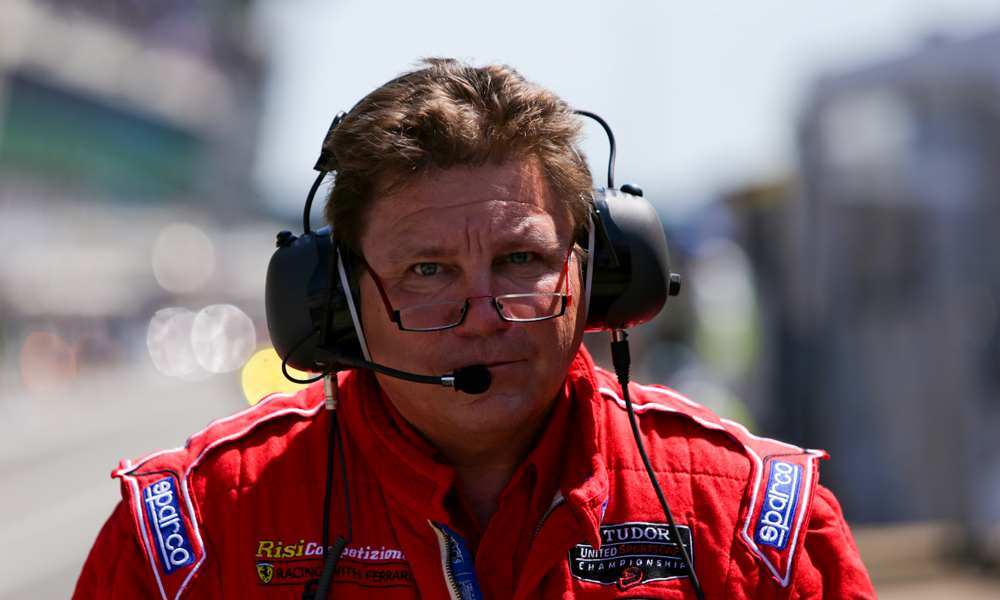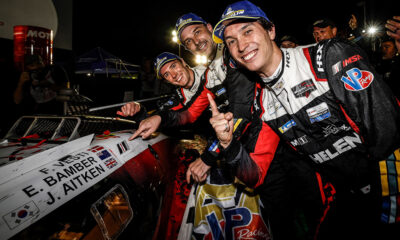
Photo: Regis Lefebure/Risi
Risi Competizione race engineer Rick Mayer previews this weekend’s Rolex 24 at Daytona. The Houston-based team expands into a two-car operation, fielding its GT Le Mans class Ferrari 488 GTE, as well as a GT3-spec Ferrari in GT Daytona for the first time.
General: This will be a little different Daytona for Risi Competizione; we’ve entered one GTLM F488 and one GTD F488 for this event. We consider this a two-car car team as opposed to two one-car teams; there’s a lot of cross over and reinforced efforts between the car crews, even though the cars are in different classes.
The total car count (50 cars) is similar to last year, but with No PCs and a larger Prototype field. The four longer endurance series races always have a larger Pro-Am content than the shorter races and this makes getting through traffic and staying clear of trouble more difficult and risky.
A driver’s mental fatigue and any lapse of concentration could easily affect the outcome. Your concentration must be high, traffic will be constant, spotters at Daytona are super important. The safety car and wave by rules will ensure a large lead lap car count for each class, as the rules make it easy to make up a small lap deficit.
Clearing traffic will be particularly difficult for GTLM as the GTDs have equal or better banking speeds and the GTDs are allowed ABS brakes.
Competitiveness: The IMSA WeatherTech-specific Balance of Performance GTLM and GTD rules evolved from the Roar earlier this month with mainly small changes for the race. Both the GTLM and GTD F488 should be competitive in their respective classes.
Based on Roar observation the best BoPs are likely the Porsches in each class. Significant? We’ll see. The fuel flow restrictors and fuel capacities have more significance at Daytona as fuel fill time and stint length are more important as in class passing will be difficult; gaining positions in the pits is low risk compared to passing on track.
In GTLM, the BMWs got a significant power increase and a weight reduction as they clearly were not on pace at the Roar. The Corvettes and Fords both saw increases in their minimum wing angle (more downforce but more drag) which will affect their banking speeds. Fuel capacities and fuel flow restrictors were also changed. The GTLM Ferrari was the only GTLM with no changes.
In GTD the Ferrari received more fuel capacity. Audi, Lamborghini lost some power (roughly 5 percent each), with BMW getting 2 percent more boost. Other manufacturers had fuel flow restrictor and fuel capacities change.
The Track: Daytona is the iconic, classic ‘Roval’ and the only ‘Roval’ we run in IMSA competition. Track grip varies with the weather conditions. Any rain will add additional complexity, and there is some rain forecasted for the race. The track surface is still relatively smooth; the infield was repaved a couple years back. The corners are all slow except the “Bus Stop” and the “Kink”.
This is all complicated by having to run very high tire pressures and very low cambers in order to diminish the chance of having banking related tire failures.
There are many ways to get a good lap time here but good stable braking, good corner exits from Turn 3, 6 and the “Bus Stop”, plus speed through the latter are key to a competitive race car.
Setup: Daytona is a track that requires some reserve in setup to increase safety. Unlike other tracks, Daytona setups only relate to Daytona. The mechanical setup and tire pressures we need to run (Daytona-only pressure and Daytona-only cambers) here are all in the direction of safety at the detriment to lap time and performance. We bias the setup to improve braking stability and traction and maximize banking speed.
You don’t setup for the infield, as it is difficult to pass there. The required high tire pressures (+10 percent) reduce front and rear grip. The increased pressures tend to bias the deficit to the rear both at corner entrance and power down at the exit.
The reduced camber safety requirements (more than one degree less negative camber) also decrease grip; all of this changes the general setup and what you expect. We’ll try and trim drag, to improve banking speed, to a limit, as IMSA rules stipulate a minimum wing angle for each GTLM car but not for the GTD cars; trimming aero is always a compromise and you need to consider forecast weather conditions.
With 50 cars you’ll be in traffic throughout the infield nearly every lap. The only legitimate passing areas are on the banking to clear slower cars, braking into Turn 1, braking into the “Bus Stop” and occasionally into Turn 5.
The better car to race is the low drag version (increased banking speed) if the lap times are similar and if braking stability into T1 and the “Bus Stop” are still competitive and if tire degradation doesn’t get excessive. Being fast in the infield section is of little advantage.
The Race: The Daytona 24 is the quintessential ‘crap shoot’ of endurance races. The field is packed and the pit lane boxes are small. You must take as much care in the pits as on the track. Luck and patience pays large dividends here more than at any other track.
The wave by rules for cautions (safety cars) are likely to ensure a large number of lead lap cars in each class in the last stints of the race. The safety car pit opening rules have changed this year as have the final way by rules putting DPis at the front of the entire field before the green.
This, along with the absence of PC cars, ‘should’ reduce the number of full course cautions.
After the opening hour you need to stay in touch with the class leader, ideally BE the class leader, and be positioned at the 20-hour for the sprint to the finish. In essence, you need to back out your strategy for the last four hours. The first 20 hours are just survival and staying on the lead lap.
Any of the nine GTLM cars could win this race, while the GTD field is more based on staying on the lead lap as the Am’s circulate through the car, or getting your lap back if you lose one.
This year the BMW is the only new car in GTLM; they struggled at the Roar with pace, but their BoP for the event has improved considerably…so we’ll see.
We have had great success with the long races at Risi Competizione. We had a good run and stayed out of trouble last year. The GTD car has two very accomplished Pro’s in the line-up and seasoned endurance Am drivers. The Pro’s know how to close a race.
We have four of the best Ferrari factory GT drivers in the GTLM car; this has to be one of the best driver line-ups in the field, as all are champions and victors in 24-hour races driving Ferraris.
Let’s hope good fortune will start at Daytona and fade the memories of 2017’s incident filled season.























